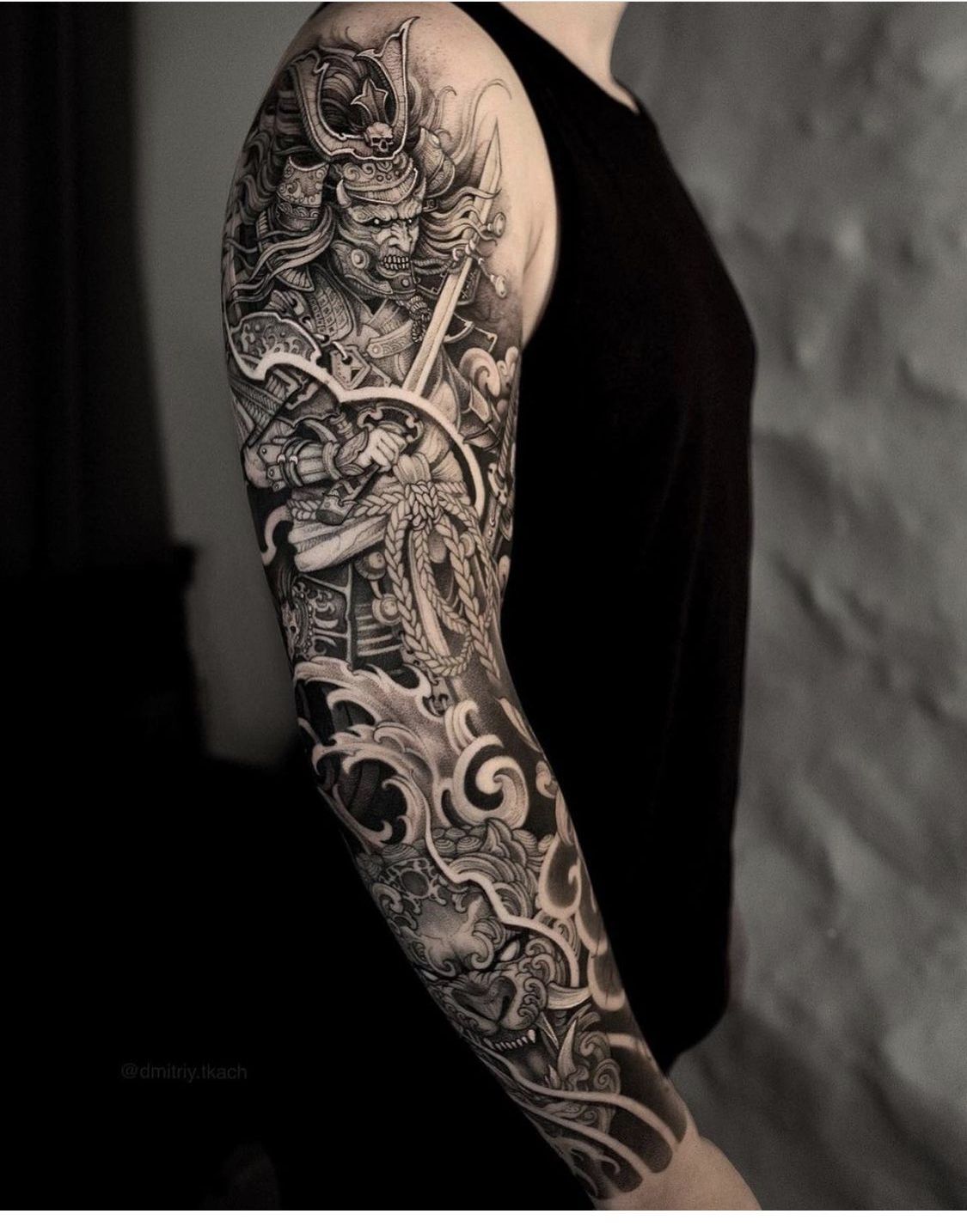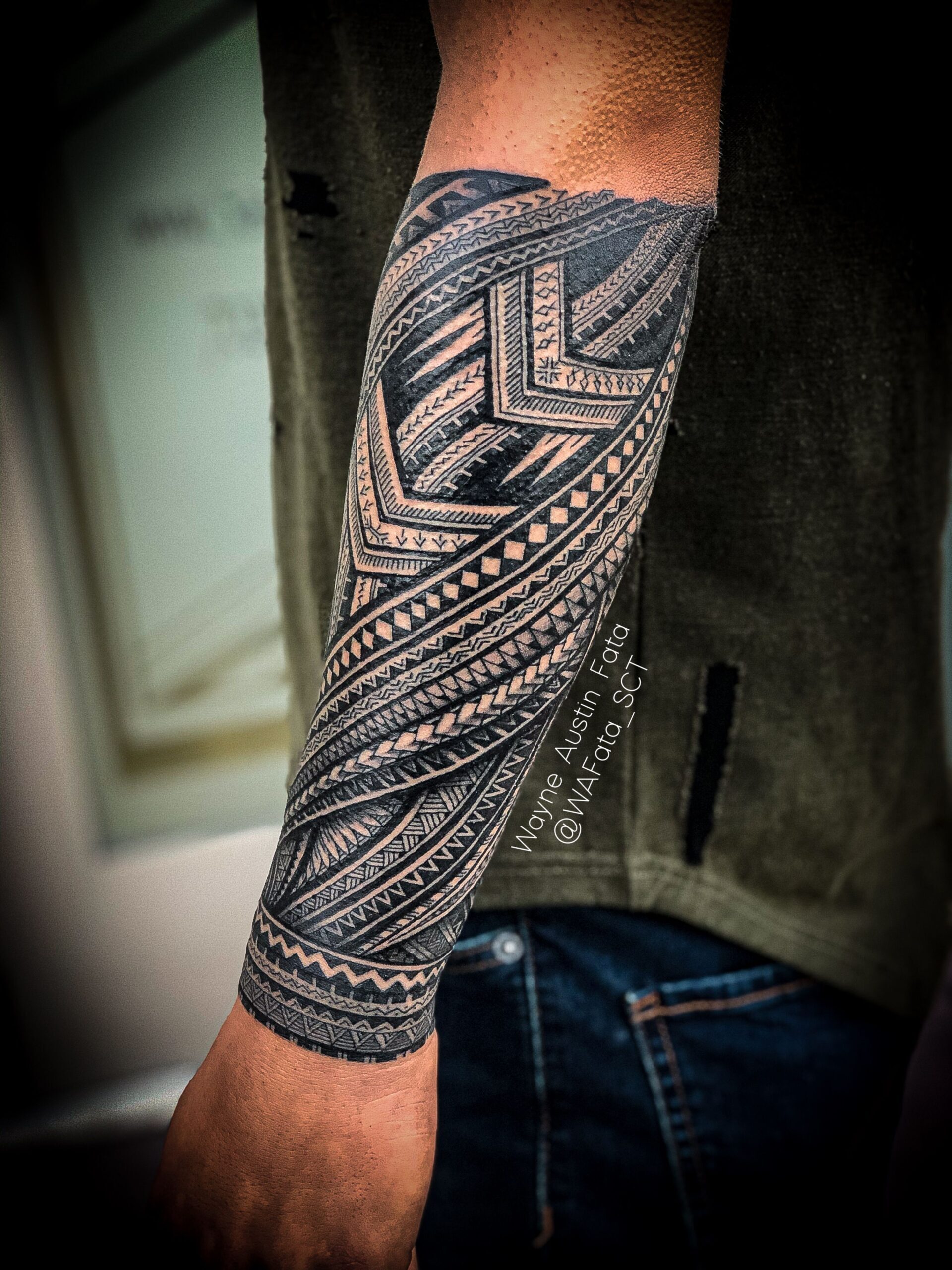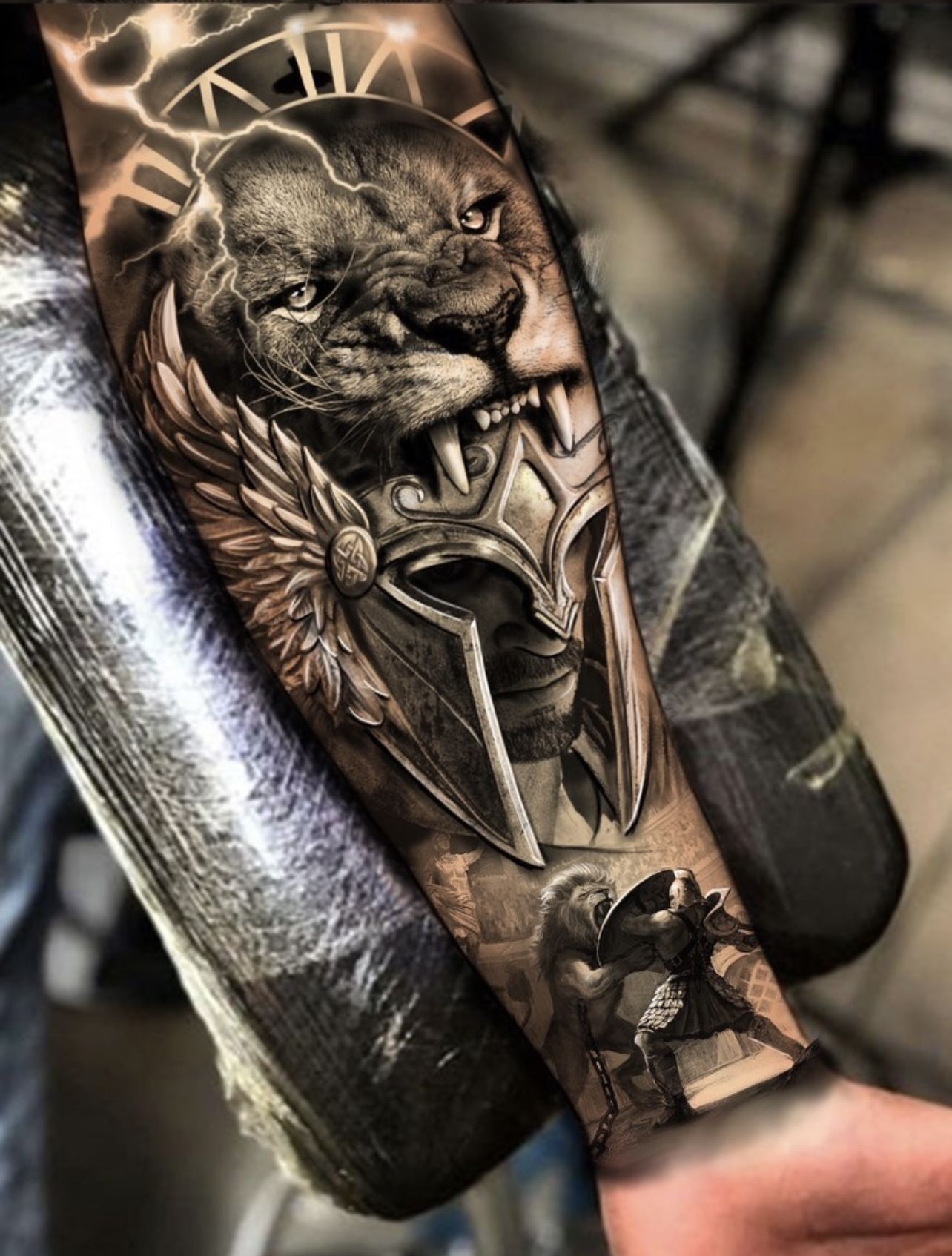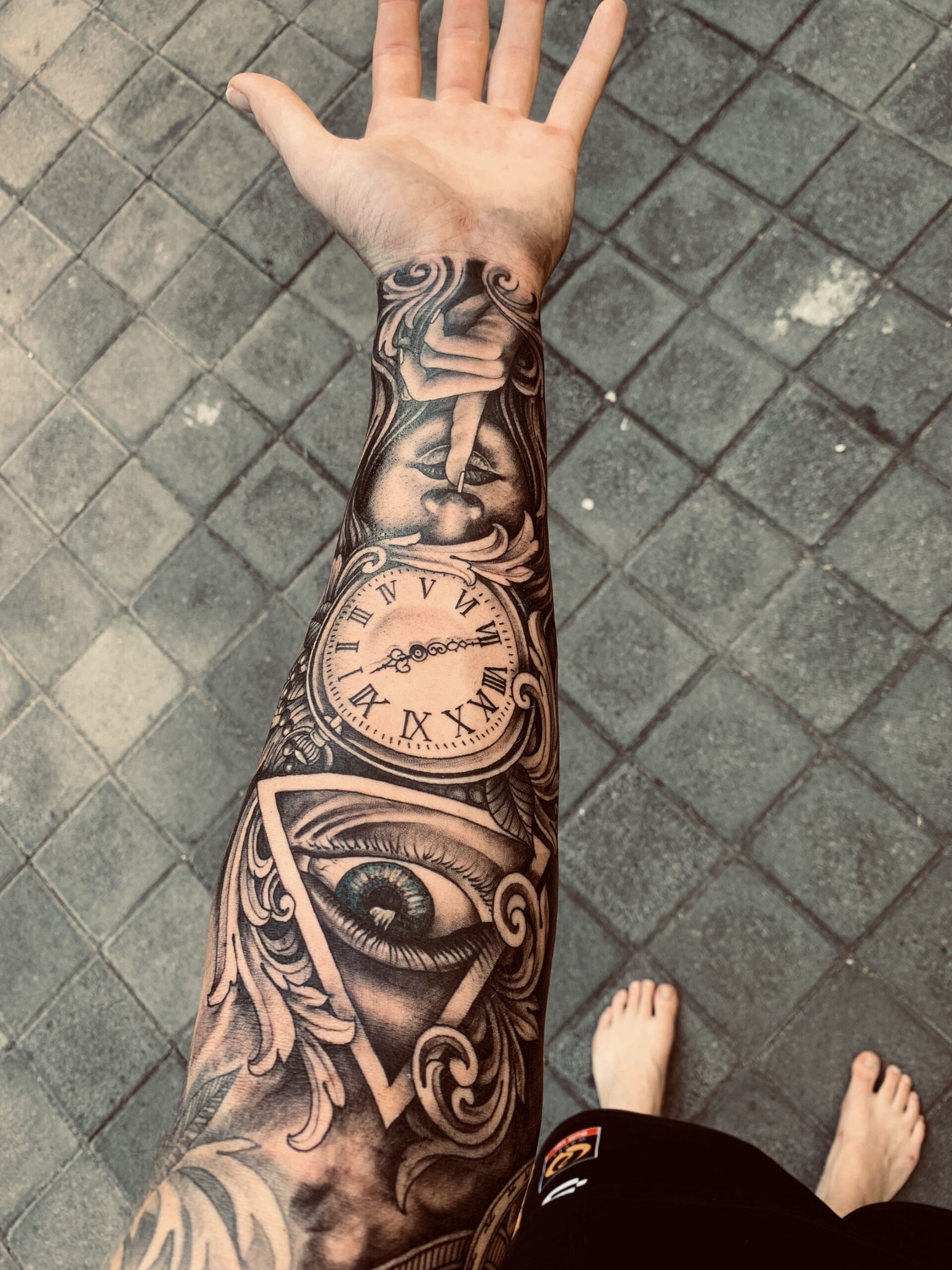In recent years, the trend of sleeve tattoos for men has gained remarkable popularity, showcasing a diverse array of designs and styles. Whether you envision a complete sleeve or a partial tattoo, this form of body art serves as a compelling means to convey your personality and interests. Delving into the world of sleeve tattoos for men, this article will provide a comprehensive exploration, covering their symbolism, meaning, and trending design concepts.
Are you only interested in tattoo designs and want to skip the educational part?
No problem, we got you covered! Click HERE to get inspired.
What does the sleeve area symbolize for men?
The sleeve area is a large, visible part of the body, which carries many symbolic meanings. For many men, the sleeve is a place to showcase their values, beliefs, and accomplishments. It can be a way to honor their heritage or pay tribute to loved ones. Some men may also see their sleeves as a canvas for creative expression or self-improvement.
What is the meaning behind sleeve tattoos for men?
Sleeve tattoos can have many meanings, depending on the design and placement. Some common themes include strength, courage, honor, and spirituality. Others may represent personal milestones, such as overcoming adversity or achieving goals. Sleeve tattoos can also be a way for men to express their unique identity or connect with their cultural heritage.
best sleeve tattoo ideas and their meanings for men
Japanese sleeve tattoos for men
These types of sleeves often feature intricate designs with bold lines and bright colors, and are inspired by traditional Japanese tattoo art. The designs may include elements such as koi fish, cherry blossoms, dragons, and samurai warriors, and often have symbolic meanings associated with them.
Tribal sleeve tattoos for men
These sleeves feature bold, black lines and shapes that are inspired by traditional tribal tattoo designs. The designs may include elements such as arrows, crosses, and animals, and can be symbolic of strength, courage, and cultural heritage.
Realistic sleeve tattoos for men
These sleeves feature highly detailed, realistic tattoo designs that can be of anything from animals and landscapes to portraits of loved ones. The level of detail and realism in these tattoos can be quite impressive, and they can be very meaningful for the person getting them.
Black and grey sleeve tattoos for men
These sleeves feature tattoo designs that are done in shades of black and grey, rather than in color. The designs can be of anything, but the lack of color can give the tattoo a more somber or serious tone.
Religious sleeve tattoos for men
These sleeves feature tattoo designs that are inspired by religious symbols or themes. The designs may include crosses, angels, and other religious iconography, and can be very meaningful for those with strong faith.
Who should get a sleeve tattoo?
Sleeve tattoos are a significant commitment, both in terms of time and money. It's important to carefully consider whether this is the right decision for you before getting a sleeve tattoo. Some things to consider include your personal style, the amount of exposure your tattoo will get in your line of work, and your ability to commit to the tattooing process. It's also important to carefully research your tattoo artist and shop to ensure you get a high-quality tattoo.
History and origin of sleeve tattoos for men
Sleeve tattoos have a long and varied history, with roots dating back to ancient cultures worldwide. In many indigenous cultures, tattoos were used as a spiritual expression, often to mark important life events or connect with one's ancestors. Sleeve tattoos gained widespread popularity in the West during the 20th century and have continued to evolve as a popular form of self-expression for men.
General Breakdown Of Tattoo Pain Levels On Different Body Parts
Here is a breakdown of the different tattoo pain levels:
- Low: This level of pain is generally described as a mild discomfort or tickling sensation. It is similar to the sensation of getting a light scratch or scrape.
- Moderate: This level of pain is generally described as a moderate discomfort or aching sensation. It is similar to the sensation of getting a deep scratch or scrape or being pinched.
- High: This level of pain is generally described as a strong discomfort or throbbing sensation. It is similar to the sensation of getting a burn or being stung by a bee.
It's important to note that pain tolerance is highly individual and can vary greatly from person to person. Some people may find certain body parts more or less painful than others, and the same body part can be more or less painful for different people. Additionally, the level of pain can be affected by factors such as the size and location of the tattoo, the skill of the tattoo artist, and the individual's own pain threshold.
Tattoo placement pain level chart
Body Part | Pain Level | Explanation |
Forehead | Low | The forehead has few nerve endings, so it is not a particularly painful area. |
Eyebrows | Low | The eyebrows have few nerve endings, so the pain level is relatively low. |
Ear | Low | The ear is a relatively thin and fleshy area, so the pain level is low. |
Nostril | Low | The nostril is a small area with thin skin, so the pain level is low. |
Lip | Low to Moderate | The lip has more nerve endings than some other areas, so it may be slightly more painful. |
Cheek | Low to Moderate | The cheek has a moderate amount of nerve endings, so it may be slightly more painful. |
Moderate | The neck has a moderate amount of nerve endings, so it may be slightly more painful. | |
Moderate to High | The chest has a high concentration of nerve endings, so it can be quite painful. | |
Abdomen | High | The abdomen has a high concentration of nerve endings, so it can be quite painful. |
Back | High | The back has a high concentration of nerve endings, so it can be quite painful. |
Shoulders | High | The shoulders have a high concentration of nerve endings, so they can be quite painful. |
Upper Arms | Moderate to High | The upper arms have a moderate to high concentration of nerve endings, so they can be somewhat painful. |
Elbows | High | The elbows have a high concentration of nerve endings, so they can be quite painful. |
Forearms | Moderate | The forearms have a moderate concentration of nerve endings, so they are not as painful as some other areas. |
Hands | High | The hands have a high concentration of nerve endings, so they can be quite painful. |
Lower Arms | Low to Moderate | The lower arms have a lower concentration of nerve endings, so they are not as painful as some other areas. |
Wrists | Low | The wrists have a low concentration of nerve endings, so they are not very painful. |
Lower Back | High | The lower back has a high concentration of nerve endings, so it can be quite painful. |
Buttocks | High | The buttocks have a high concentration of nerve endings, so they can be quite painful. |
Thighs | High | The thighs have a high concentration of nerve endings, so they can be quite painful. |
Knees | High | The knees have a high concentration of nerve endings, so they can be quite painful. |
Calves | Low to Moderate | The calves have a low to moderate concentration of nerve endings, so they are not as painful as some other areas. |
Ankles | Low | The ankles have a low concentration of nerve endings, so they are not very painful. |
Tattoo aftercare tips
Before getting a tattoo:
Choose a reputable tattoo artist and parlor. Research the artist's portfolio and read reviews from previous clients.
Consult with the artist about the design and placement of the tattoo.
Make sure you are in good health. If you have any medical conditions or are taking any medications that may affect your ability to heal, be sure to let your tattoo artist know.
Consider using a numbing cream to reduce pain during the tattooing process. These creams contain a numbing agent (such as lidocaine) that can be applied to the skin before the tattoo is done. It's important to follow the instructions on the numbing cream and to only use it as directed.
Avoid alcohol, caffeine, and other substances that can thin your blood for at least 24 hours before getting a tattoo.
Eat a healthy meal before your tattoo session to ensure that your blood sugar is stable.
Wear loose, comfortable clothing that allows easy access to the area being tattooed.
After getting a tattoo:
Follow the aftercare instructions provided by your tattoo artist. These may include:
Keeping the tattoo clean and covered with a bandage for the first few hours after getting tattooed.
Washing the tattoo with lukewarm water and a mild soap (such as unscented, antimicrobial soap) and patting it dry with a clean towel.
Applying a thin layer of tattoo ointment or lotion (such as A&D or Aquaphor) to the tattoo and covering it with a clean bandage or wrap.
Repeating this process for the first few days, or until the tattoo has fully scabbed over.
Avoid soaking the tattoo in water for the first week, such as in a bath or pool.
Avoid picking or scratching at the scabs, as this can cause the tattoo to fade or become infected.
Avoid exposure to direct sunlight or tanning beds for at least 2-4 weeks.
If you experience any redness, swelling, or unusual discharge, contact your tattoo artist or a healthcare professional.
Overall, it's important to keep your tattoo clean and moisturized during the healing process to ensure that it heals properly and looks its best. Using a numbing cream can help reduce pain during the tattooing process, but it's important to use it as directed and to follow all aftercare instructions to ensure that your tattoo heals properly.
People Also Ask:
How much does a full-sleeve tattoo cost?
The cost of a full-sleeve tattoo can vary widely depending on the size, complexity, and location of the tattoo. On average, you can expect to pay anywhere from $500 to $5000 or more for a full-sleeve tattoo.
How long does it take to get a full sleeve tattoo?
The time it takes to complete a full sleeve tattoo can also vary widely depending on the size, complexity, and location of the tattoo. A small, simple tattoo may take just a few hours to complete, while a large, detailed tattoo can take several sessions over several weeks or months.
Can you cover up a full sleeve tattoo?
It is possible to cover up a full sleeve tattoo with another one. The success of the cover-up will depend on the size and complexity of the original tattoo, as well as the skill and experience of the tattoo artist. Adding additional layers of ink or using more complex cover-up techniques may be necessary to fully conceal the original tattoo.
Can you get a full sleeve tattoo in one session?
Getting a full sleeve tattoo in one session is generally not recommended. Not only can this be physically taxing for the tattoo artist and the client, but it can also increase the risk of complications such as infection or scarring. It is generally best to spread the tattooing process over several sessions to allow the tattoo to heal properly between sessions.
Is it painful to get a full sleeve tattoo?
The pain associated with getting a full-sleeve tattoo can vary widely depending on the individual's pain tolerance and the location of the tattoo on the body. Some people may find the pain minimal, while others may experience more intense discomfort. It is generally best to discuss any concerns about pain with the tattoo artist beforehand and to take appropriate steps to manage pain during the tattooing process, such as taking pain medication or using numbing creams.
Watch A Video Of A full sleeve tattoo for men Done By A Pro:
199+ Full sleeve tattoos To Get Inspired From
Final thoughts:
Sleeve tattoos for men can be a powerful way to express oneself and pay tribute to important values and beliefs. Whether you choose a traditional, tribal, or contemporary design, a sleeve tattoo can be a meaningful and long-lasting addition to your body art. It's important to carefully consider whether this is the right decision for you and to choose a reputable and skilled tattoo artist to ensure the best possible results.






